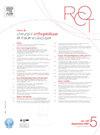脚趾畸形如何分类和治疗?
Q4 Medicine
Revue de Chirurgie Orthopedique et Traumatologique
Pub Date : 2024-08-28
DOI:10.1016/j.rcot.2024.07.028
引用次数: 0
摘要
对足趾畸形进行分类可以让我们有的放矢地确定手术适应症。AFCP 分类提供了标准化的形态描述。它报告了每个脚趾节段从近端到远端的位置。其快速性和可重复性已得到证实。矢状畸形是最常见的畸形,多为机械性畸形,但也可能是神经性、风湿性、先天性、创伤后或先天性原因所致。临床检查的重点是确定畸形的原因并评估其对功能的影响。还原性试验和寻找不稳定性或跖趾脱位(MTP)将决定治疗方法的选择。除了标准的系统放射学评估外,超声波甚至核磁共振成像也可用于更好地分析跖趾不稳定性。如果足病治疗和物理疗法不能充分缓解症状,则需要进行手术治疗。只要有可能,治疗畸形的病因可确保获得最佳疗效。然后可以通过对骨骼和/或软组织的综合治疗来矫正畸形。经皮手术尤其适合这种顺序治疗。选择使用的技术应从近端到远端,必要时在 MTP 顺序矫正畸形,然后是近端指间关节 (PIP),最后是远端指间关节 (DIP)。每种矢状畸形或水平畸形的表格都总结了与最近发表的文章一致的治疗方案。对足趾畸形进行分类有助于我们确定手术适应症。AFCP 分类提供了标准化的形态描述。它报告了每个脚趾节段从近端到远端的位置。其快速性和可重复性已得到证实。矢状畸形是最常见的畸形类型,多为机械性畸形,但也可识别神经性、风湿性、先天性、创伤后和先天性原因。临床检查的目的是确定畸形的原因并评估其对功能的影响。还原性检查和寻找跖骨不稳或不稳定或跖趾脱位(MTP)将决定治疗方法的选择。除了标准的系统放射学检查外,超声波甚至核磁共振成像也可用于更好地分析跖趾不稳定性。当足病治疗和理疗无法充分缓解症状时,就需要进行手术治疗。在可能的情况下,治疗畸形的原因是取得成功的最佳保证。然后通过对骨骼和/或软组织畸形采取综合措施来矫正畸形。经皮手术尤其适合这种顺序治疗。选择使用的技术是从近端到远端,必要时依次矫正 MTP 的畸形,然后是近端指间关节 (PIP),最后是远端指间关节 (DIP)。每种矢状或水平畸形类型的表格中都总结了与近期发表的文献一致的治疗方案。证据等级:V;专家意见。本文章由计算机程序翻译,如有差异,请以英文原文为准。
Comment classer et traiter les déformations des orteils ?
Classer les déformations des orteils permet de cibler nos indications chirurgicales. La classification de l’AFCP permet leur description morphologique standardisée. Elle rapporte la position de chaque segment d’orteil de proximal à distal. Sa rapidité et sa reproductibilité sont démontrées. Les déformations sagittales, les plus fréquentes, sont le plus souvent d’origine mécanique mais des causes neurologiques, rhumatismales, congénitales, post-traumatique ou iatrogènes sont possibles. L’examen clinique s’attache à rechercher la cause de la déformation et à évaluer son retentissement fonctionnel. Le test de réductibilité et la recherche d’une instabilité ou d’une luxation métatarsophalangienne (MTP) seront déterminants pour le choix thérapeutique. En plus du bilan radiologique standard systématique, une échographie, voir une IRM peuvent être utilisés pour mieux analyser une instabilité métatarsophalangienne. Lorsque les mesures podologiques et la kinésithérapie ne permettent pas un soulagement suffisant, le traitement chirurgical est indiqué. Chaque fois que cela est possible le traitement de la cause de la déformation est le garant d’un meilleur résultat. Puis, une association de gestes sur les os et/ou les parties molles permet de corriger la déformation. La chirurgie percutanée est particulièrement adaptée à ce type de prise en charge séquentielle. Le choix des techniques à utiliser se fait de proximal à distal, on corrige séquentiellement si nécessaire la déformation au niveau de la MTP puis de l’articulation interphalangienne proximale (PIP) et enfin de l’articulation interphalangienne distale (DIP). Un tableau pour chaque type de déformation sagittale ou horizontale résume les possibilités thérapeutiques en accord avec les publications récentes. Niveau de preuve : V ; avis d’expert.
Classifying toe deformities enables us to target our surgical indications. The AFCP classification provides a standardized morphological description. It reports the position of each toe segment from proximal to distal. Its rapidity and reproducibility have been demonstrated. Sagittal deformities, the most frequent type of deformity, are most often mechanical in origin, but neurological, rheumatic, congenital, posttraumatic and iatrogenic causes can also be identified. The clinical examination aims to identify the cause of the deformity and assess its functional impact. The reducibility test and the search for metatarsal instability or instability or metatarsophalangeal dislocation (MTP) will determine the choice of choice of treatment. In addition to the standard systematic radiological work-up, ultrasound and even MRI can be used to better analyze metatarsophalangeal instability. When podiatric measures and physiotherapy fail to provide sufficient relief, surgical treatment is indicated. Whenever possible treatment of the cause of the deformity is the best guarantee of a successful outcome. The deformity is then corrected by a combination of actions on the bone and/or soft tissue deformity. Percutaneous surgery is particularly well suited to this type of sequential management. The choice of techniques to be used is made from proximal to distal, with sequential correction if necessary of the deformity at the MTP, then the proximal interphalangeal joint (PIP) and finally the distal interphalangeal joint (DIP). A table for each type of sagittal or horizontal deformity summarizes treatment options in line with recent publications. Level of evidence: V; expert opinion.
求助全文
通过发布文献求助,成功后即可免费获取论文全文。
去求助
来源期刊

Revue de Chirurgie Orthopedique et Traumatologique
Medicine-Surgery
CiteScore
0.10
自引率
0.00%
发文量
301
期刊介绍:
A 118 ans, la Revue de Chirurgie orthopédique franchit, en 2009, une étape décisive dans son développement afin de renforcer la diffusion et la notoriété des publications francophones auprès des praticiens et chercheurs non-francophones. Les auteurs ayant leurs racines dans la francophonie trouveront ainsi une chance supplémentaire de voir reconnus les qualités et le intérêt de leurs recherches par le plus grand nombre.
 求助内容:
求助内容: 应助结果提醒方式:
应助结果提醒方式:


